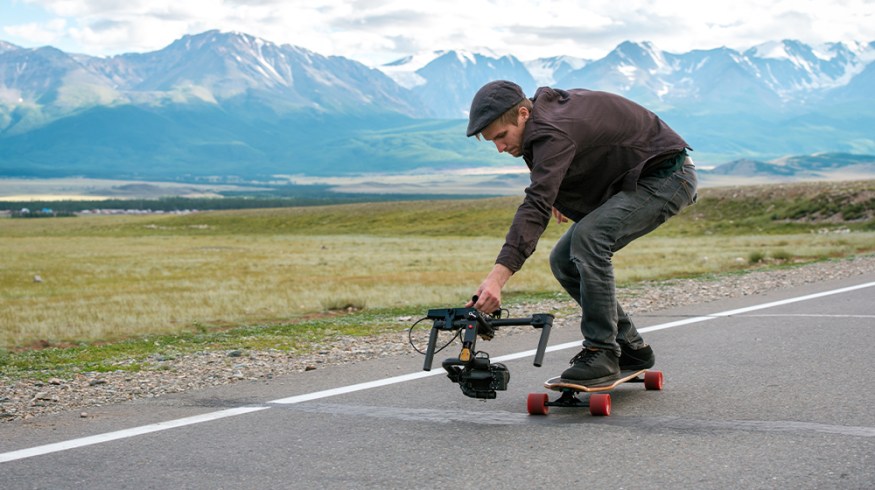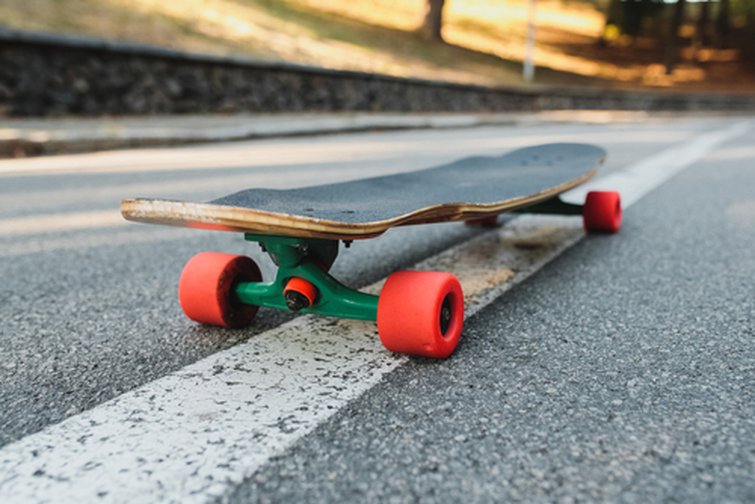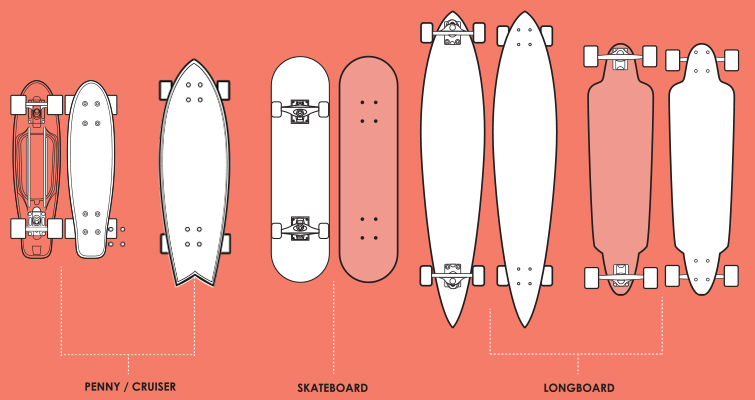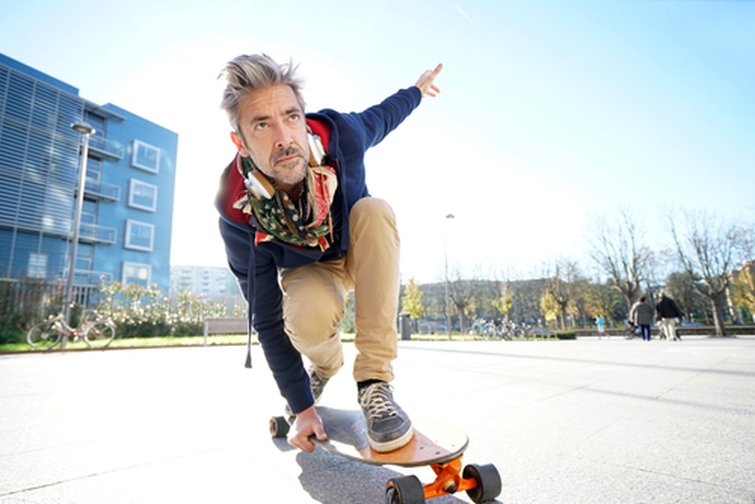
Choosing the Right Skateboard to Pair with a Gimbal
Find out what type of board is not only smoothest, but safest, to pair with a gimbal for ultra-smooth filming.
In September of 2020, I turned 30. Unshackled by the ideology of caring what others think about you—as often touted as one of the qualities of leaving your twenties—I decided to pick up something I dropped at 19, a skateboard.
I was an advent surfer from 14-19, and influenced by the 2009 release of Skate 2, I decided to pick up a skateboard with the one goal of learning how to ollie. After accomplishing said goal, I sold the skateboard. Given my current form of cardio has now switched from running to learning the board again, it’s something I wish I kept at. That aside, 2020 has also seen a rise in people of all ages picking up the hobby. Skateboarding’s resurgence is a by-product of both worldwide lockdowns and the launch of the sensational remaster of Tony Hawks Pro Skater 1 & 2, games that revolutionized the sport back in the late 90s.
But, this is a filmmaking blog, and I’m sure you don’t need to know about skateboard sales. So, how about we look at pairing a gimbal with a board for ultimate smooth operation?

Filming with a Skateboard and Gimbal
Of course, the notion of filming while on a skateboard isn’t a revolutionary concept. It’s been done since the conception of handheld camcorders and is primarily why some professional skateboarders have had careers. Without a filmer (a term used for someone riding and filmmaking), how are you going to show off your skills?
However, the aesthetic of riding the camera low to the ground with a fisheye lens isn’t exactly prime narrative filmmaking material. Camera technology has, of course, blossomed massively since the early 2000s, and now you can easily get fast, steady camera movement with a gimbal and set of sturdy legs. But, how about moving quicker, and ultimately, smoother, with a skateboard?
At this point, it should probably be wise to suggest that if you have never ridden a skateboard before, we don’t recommended you jump on one straight away equipped with a gimbal and expensive camera. There’s a reason as to why you see some skateboarders padded from head to toe.
However, this isn’t an article on how to ride a skateboard. It’s an article on which board you should use to get the smoothest footage. To do that, we have to consider two things—the size and type of board you’re going to use and what type of wheels they have.
Skateboard Wheels
First, let’s look at the wheels. Two parameters of the wheels will help you obtain better, smoother shots—their size and hardness.

Wheel diameter is measured in millimeters (mm), and you’ll find most wheels in the range of 50-75mm. The diameter of the wheel will affect how quickly you accelerate and also how fast you can turn. Smaller wheels usually result in a slower ride, whereas larger wheels will give you momentum. That may seem like I’m advocating for smaller wheels when using a gimbal. However, the larger wheels are also smooth and will ride over cracks and small holes in the pavement with ease. The last thing you want is to come to a small stone on a smaller wheel and fly off your board.
Additionally, and most importantly, larger wheels also offer greater balance. This makes them a better choice for casual riding. Or, in our case, casual filming.
Warehouse Skateboards lists the sizes as following:
- 50-53mm – Small, slower wheels, stable for trick riding and smaller riders skating streets, skate parks, and bowls.
- 54-59mm – Average wheel size for beginners and bigger riders skating streets, skate parks, bowls, and vert ramps.
- 60mm + – Specialty riders skating longboards, old-school boards, downhill, and dirt boards. Made for speed and rougher surfaces.
In our case, we’d want to look at wheels at 60mm+.
Additionally, the hardness of the wheels will also affect how the board rolls and grips the floor. Generally, the harder the wheel, the faster you’ll go. The softer the wheel, the slower your speed, plus the more grip you’ll have.
Again, Warehouse Skateboards has a good list that breaks down the difference.
- 78a-87a – Soft wheel good for rough surfaces, longboards, or street boards that need lots of grip to roll over cracks and pebbles easily. Designed for smooth rides, cruising, longboards, hills, and rough surfaces.
- 88a-95a – Slightly harder and faster with a little less grip, but the grip’s still good. Good for street and rough surfaces.
- 96a-99a – Nice speed and grip—an all-around good wheel. Perfect for beginners skating streets, skate parks, ramps, pools, and other smooth surfaces.
- 101a+ – Hardest and fastest wheel with the least grip. Ineffective on slick and rough surfaces. These are pro wheels.
- 83b-84b – Wheels using the B scale are extremely hard, measuring 20 points fewer than the A Scale to allow the scale to extend another 20 points for the hardest wheels.

Now, we could look at combining the two elements. Having a larger wheel that’s is perfect for rough surfaces and a softer wheel that yields lots of grip would make sure we ride comfortably with the gimbal. However, larger wheels are typically suited to a specific type of board. Let’s see which one.
Which Board?
While the standard skateboard—pictured above—is what you may be familiar with, there are three primary types of boards to purchase.

Skateboard: These measure 28″ to 32″ and are the shortest and lightest boards on the list. These are the boards you’ll typically see people riding at a skatepark, and they are designed and shaped for getting air and performing tricks. Due to their size, they aren’t truly ideal for what we want to achieve.
Cruiser: Cruiser boards won’t be that much longer than a skateboard as they usually finish at 34.” However, and essential for filmmaking, they’re much wider than your typical skateboard. They are also hosts to larger wheels, making cruisers maneuverable, rendering them perfect for cruising the streets and turning tight corners. But, this leads them to be heavier as well.
Longboards: A longboard is a skateboard with a deck longer than 36,” but you’ll typically find them much longer than that. Due to their extended size, they’re more stable and smoother when riding longer distances and at higher speeds. Additionally, they generally allow for more efficient and effortless pushing.

While I’m sure many adequately skilled people can film steadily on a skateboard with a gimbal, I recommend veering away from the standard skateboard. Instead, look at either buying a cruiser or longboard. Plus larger wheels are primarily designed for cruiser boards and longboards.
Cruiser vs. Longboard
We know for maximum stable riding, we need large, smooth wheels, but how do we decide between the cruiser and longboard when they seem to offer the same level of smoothness?
Well, while cruiser boards typically can’t handle the speeds that a longboard can because of the short wheelbase (the short wheelbase, combined with loose trucks, often leads to speed wobbles), we’re not going to be riding fast with our gear. Instead the choice is going to depend on where you’re likely to be pairing the gimbal.
A cruiser is more responsive and ideal for riding in tight, inner-city areas with varying obstacles. A full-size longboard requires a broader radius to turn, but also offers more stability.

So, if you’re looking to create stable content along a smooth coastal path, with little-to-no turns and obstacles, and want to expel as little energy as possible, look to invest in a longboard.
If your content is set to take place in confined areas, and you need the maneuverability to carve between obstacles, pick up a cruiser.
Whatever board you decide to use to get ultra-smooth, fast gimbal content, make sure you’re familiar with the board and have outstanding balance.
Additionally, make sure you’re padded up! You can replace a camera lens if you fall off, but you can’t replace your skull.
Perhaps you can go a step ahead of the curve and, instead, pair a gimbal with a OneWheel?
For additional DIY filmmaking tips, check out these articles:
- DIY: How to DIY a Green Screen on a Budget
- A Cheap Trick for Lighting a Daylight Interior Car Scene
- DIY Filmmaking Tips: Building a Heavily Diffused $50 Light
- A Guide to Creating High-Quality Run-and-Gun Vlog Videos
- Video Tutorial: Build Your Own $50 Car-Side Camera Mount
Cover image via Dmitriy Kozhanov.






